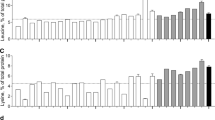Summary
The availability of zinc from two semi-synthetic diets with isolated whey protein (Wp D) or with isolated casein (Cas D) as protein component (20% W/ W) was compared in a 21-day study with growing male rats (initial weight 40 g; 14 animals/group). Zinc concentration in both diets (18 ppm) was adequate to meet the requirements of the animals fed ad libitum. For radiolabeling ∼ 13μg65Zn (=4 μ Ci) was given daily by intragastric intubation to each animal. The investigation was designed primarily as a retention study, but also general parameters like weight development, food and water intake, organ weights etc. were registered and the activity of alkaline phosphatase was determined in serum and femur tissue. A significantly higher percentage of65Zn was retained in the whole body from the Wp D (36.5%) than from the Cas D (31.6%) during the experimental period. The same is valid for the percentage retention of65Zn in the femur and for the65Zn concentration in femur and hair as well as for the total zinc concentration (65Zn and non-labeled zinc) of the femur. The other parameters determined were not unequivocally influenced by the protein component of the diet. The study clearly demonstrated that the availability of zinc by the growing rat was better from a diet with whey protein than from one with casein as the protein component. The reason on this phenomenon has to be elucidated by further investigations.
Zusammenfassung
Ziel der Untersuchung war es, die Verfügbarkeit von Zink aus zwei semisynthethischen Kostformen, die isoliertes Molkenprotein (Wp D) bzw. isoliertes Casein (Cas D) als Proteinkomponente (20 Gew.%) enthielten, zu vergleichen. Je 14 wachsende männliche Ratten pro Gruppe (Anfangsgew. 40 g) wurden mit diesen Diäten 21 Tage lang ad libitum gefüttert. Die Kostformen enthielten mit 18 ppm eine bedarfsdeckende Zinkdosis. Zur radioaktiven Markierung des Zinks wurden jedem Tier täglich ∼ 13 μg65Zn (=4 μ Ci) intragastral gesondet. Die Untersuchung war hauptsächlich als Retentionsstudie angesetzt, es wurden jedoch auch allgemeine Parameter wie Gewichtsentwicklung, Futter- und Trinkwasseraufnahme, Organgewichte u. a. erfaßt und die Aktivität der alk. Phosphatase in Serum und Femurgewebe bestimmt. Während der Versuchsperiode wurde aus der Wp D signifikant mehr65Zn (36,5%) im Ganzkörper retiniert als aus der Cas D (31,6%). Analoges gilt für die65Zn-Retention im Femur und für die65Zn-Konzentration im Femur und Haar sowie für die Gesamt-Zink-Konzentration (65Zn und nicht markiertes Zink) im Femur. Bei den sonstigen Parametern war kein eindeutiger Einfluß der Proteinkomponente festzustellen. Die Untersuchung hat eindeutig bewiesen, daß das Zink aus einer Kostform mit Molkenprotein besser verfügbar ist als aus einer Diät mit Casein als Proteinkomponente. Den Grund hierfür sollen weitere Experimente klären.
Similar content being viewed by others
References
Deutsche Gesellschaft für klinische Chemie (1972) Z klin Chemie u klin Biochemie 10:182
Forbes RM, Parker HM (1977) Biological availability of zinc in and as influenced by whole-fat soy flour in rat diets. Nutr Rep Int 15:681–688
Hambidge KM, Walravens PA, Casey CE, Brown RM, Bender C (1979) Plasma zinc concentrations of breast-fed infants. J Pediatrics 94:607–608
Kirchgessner M, Roth HP (1975) Bestimmung der Verfügbarkeit von Zink im Stoffwechsel sowie Ermittlung des Zinkbedarfs mittels Aktivitätsänderungen von Zink-Metallo-Enzymen. Arch Tierernährung 25:83–92
Lowry OH, Rosebrough NJ, Farr AL, Randau RJ (1951) Protein measurement with the folin phenol reagent. J Biol Chem 193:265–275
MacDonald L, Gibson RS, Shapcott D (1981) The zinc status of breast and bottle fed infants. In: Gawthorne JM, McHowell JM, White CL (eds) Trace element metabolism in man and animals; Springer-Verlag, Berlin Heidelberg New York, p 257–260
Momĉilović B, Belonje B, Giroux A, Shah BG (1975) Suitability of young rat tissue for a zinc bioassay. Nutr Rep Int 11:445–452
Momĉilović B, Belonje B, Giroux A, Shah BG (1975) Total femur zinc as the parameter of choice for a zinc bioassay. Nutr Rep Int 12:197–203
Nutrient requirements of laboratory animals (1962) National Academy of Sciences — National Research Council, Publ 990
Parker HE (1963) Atomic absorption newsletter No 13
Rehner G, Heil M, Auge M, Harzer G, Daniel H (1985) Effect of proteins on availability of zinc. I. Gastrointestinal transit time of casein and whey protein and zinc absorption in weaned rats. Z Ernährungswiss 24:245–255
Renner E (1982) Milch und Milchprodukte in der Ernährung des Menschen. F Pustet Vlg Regensburg, p 109–110
Roth HP, Kirchgessner M (1974) Zum Einfluß unterschiedlicher Diätzinkgehalte auf die Aktivität der alkalischen Phosphatase im Knochen. Z Tierphys Tierern Futtermittelkd. 33:57–61
Author information
Authors and Affiliations
Rights and permissions
About this article
Cite this article
Auge, M., Kreiling, R., Harzer, G. et al. Effect of proteins on availability of zinc II. Bioavailability of zinc from casein and whey protein — retention study in young rats. Z Ernährungswiss 25, 233–241 (1986). https://doi.org/10.1007/BF02019574
Received:
Published:
Issue Date:
DOI: https://doi.org/10.1007/BF02019574




